tamuramachi
8 posts
A Tamura Yumi fan account. Occasionally posting amateur translations of various media related to Tamura.
Don't wanna be here? Send us removal request.
Text
[Eng] Yumi Tamura's Message to Fumi Yoshinaga in Ōoku Vol. 19 Special Edition

[^Image is a cropped & monochrome copy of original*]
Fan translation of Tamura’s congratulatory message to Yoshinaga. The original message and accompanying illustration was included in the Special Edition of Ōoku’s final volume, released on February 26, 2021.
—————————
“Fumi Yoshinaga,
Congratulations on the completion of Ōoku!
Well done on your hard work throughout the 16-year serialization! It’s a crowning achievement! The series was magnificent! Captivating! Just amazing. I was fully immersed in it. I can’t help but be green with envy, wondering how you could create such a work of art.
As I read your work, I constantly thought about what you wanted to say in it. I kept looking at the predicaments, conflicts, and heroic way of life of each man and woman, while being swept up in the interpretations that my mind could reach, but also by a strong belief and suspicion that there must be something different hidden in them. I really enjoyed it.
Due to a plague like (just like!) in the story, we can no longer see each other as often, but you always have my support. And someday, I would love to taste your scrumptious home-cooked food again.”
TAMU
Yumi Tamura
(In a side comment, Tamura explains that she drew Yoshimune because Yoshimune is from Wakayama/Kishū Domain like Tamura)
—————————
*For the full image in color (not to mention other great content), please purchase an official copy of the special edition. Digital version available on Bookwalker Japan (using a registered “Global” account is OK). Physical version available on Amazon Japan, CD Japan, or wherever you typically order similar products. To find the edition, input the following keywords in the search bar: 大奥 公式ビジュアルファンブック大奥-没日後録-付き特装版
15 notes
·
View notes
Text
Totonou Kunou & Yumi Tamura's 2021 Magademy Award Acceptance Speech
Fan translation of Totonou and Tamura's comments on winning the inaugural Magademy Award for Best Lead Male Actor (fictional character), as posted on the Flowers twitter account on March 17, 2022.
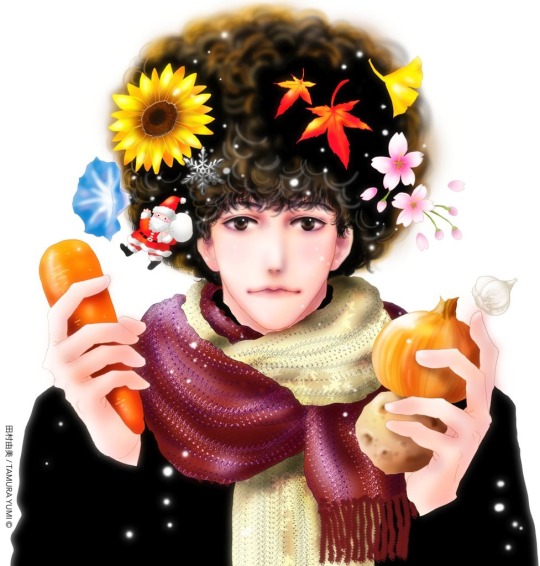
Totonou Kunou's Acceptance Speech:
Hello, my name is Totonou Kunou. I’m sorry I couldn’t come see you all today. I’m completely surprised to suddenly receive the Magademy Award for Best Actor* in a Leading Role. Thank you. However, although people say I play the lead role, it only happens to appear that way because the story is depicted from my point of view; if you look at it from Garo's point of view, Garo is the lead, and if looking from Leica's point of view, Leica is the lead. Naturally, everyone plays the lead role in their own life, but at the same time, everyone plays a supporting role in someone else's. A single incident occurring in the world can be largely different [to each person] depending on where one crops [the frame of view] and from where they look at it. And what each of us sees I'm sure is at odds with one another. It's troublesome. And always complicated. So I've always thought that I need to pay attention. I want to bear in mind that other people besides myself are living, feeling, and thinking too. Also, people may not be saying "actor" [male actor] or "actress" [female actor] anymore [i.e., moving away from gender-specific titles]. But in this situation, thank you for awarding me the first Best Actor. May I still speak? I would like to send my gratitude to everyone who nominated and selected me for this award. I hope everyone had lots of fun. If you feel tired, please get some rest. If possible, take a break before you get tired. Thank you very much. I appreciate your continued support. - Totonou Kunou
Yumi Tamura's Acceptance Speech:
I am truly grateful to receive this prestigious, first-ever Best Actor in a Leading Role Award. I never thought our Totonou would win this, and I'm shaking with surprise and excitement over it. This story began as a one-shot reading. With a lot of support, it became a serialized work, a live-action TV series starring Masaki Suda, and in the same way, it received an award, which marked the beginning of that award's history. Totonou, as with this entire work, has been nurtured by all of you. Totonou has shown me a new world. He is making me happy. I want to make him happy. May we gather up each happiness in this world. I'm wishing for that. As I think carefully about what happiness is. I appreciate your continued support. Thank you so much for today. - Yumi Tamura
----------------------------------
*T/N: The original award title specifies male actor (男優), as Magademy has a separate category for female actor, so I modeled the Japanese award titles after the traditional English ones of "Best Actor" and "Best Actress" like those of the Academy Awards (Oscars).
14 notes
·
View notes
Text
[Eng] Special Conversation between Yumi Tamura & Masaki Suda on Mystery to Iunakare
Published in the February 2022 issue of Flowers manga magazine (月刊flowers) released on Dec. 27, 2021.
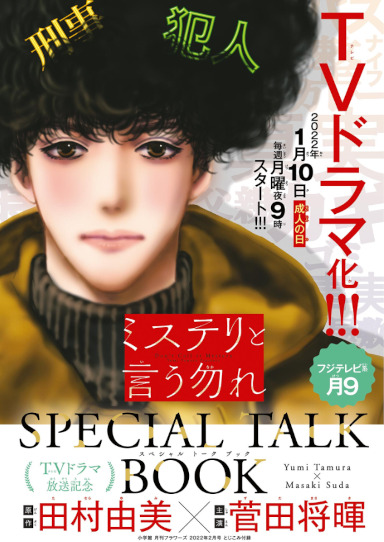
In commemoration of the [Mystery to Iunakare] TV drama adaptation, we held a special conversation between the original author, Yumi Tamura, and the lead actor, Masaki Suda. The conversation ranged from each of their thoughts on “Totonou Kunou” to discussing the highlights of the TV drama, their interactions before the filming, and their favorite manga works! Their conversation reveals at length the appeal of Mystery to Iunakara (abbreviated as Mystery).
~~~~~~~~~~~~~~
Notes:
Spoiler Alert: The conversation touches on contents in volumes 4 and 5 of the manga, some of which I believe starts being revealed on episode 5 of the TV drama (airing Feb. 7, 2022). Though no major plot spoilers are revealed (probably not fully understandable without context anyway), character names, certain events that occur, themes, and suggestions of mood/tone of certain parts are conveyed. If you want to remain completely “in the dark” about volumes 4 and 5 (episode 5 and onward in the drama) until you actually experience them, then do not proceed. If you don’t mind knowing some things without context, then feel free to read on. However, in either case, you may still want to skip over Caption 4 (see Note # 5), as I think it may kind of spoil a surprise later on leading up to volume 9 if you haven't read up to that point.
The terms “original work” and “manga” are used interchangeably in this fan translated version when referencing Mystery to Iunakare manga.
Stating the obvious that this is a fan (amateur) translation for the purposes of practice and spreading awareness of Yumi Tamura and her work. Copyright belongs to Yumi Tamura and Shogakukan. I do not claim accuracy on these translations, and in fact, may revise them from time to time. Corrections are welcomed.
If you’re able, please give support and let the publisher (and manga author) know that you enjoy this manga, this kind of special content, and would like more in the future by purchasing the original publication. Digital version is available to purchase on Book Walker Japan (https://bookwalker.jp/de41a49e7d-4bfd-4a82-a1d4-1536484849b2/). If the link doesn’t work, try copying & pasting “月刊flowers 2022年2月号” in the search bar, even on other sites where you can purchase similar Japanese publications (that accept your country’s currency). Note that you will need to register an account on Book Walker, either a Japan or Global account, to make purchases on the site.
I purposely excluded the images from this interview but included the image captions, except the bios for Tamura and Suda. They are labeled with caption numbers and appear as small, green italic text throughout. So, if you would like the full experience, not to mention a peak at other great works included in the magazine, do purchase the original. 😊
/end Notes
~~~~~~~~~~~~~~
TV Drama Adaptation Confirmed…
------First of all, Ms. Tamura, can you please share what your honest feelings were when you received the announcement about the drama adaption?
Yumi Tamura (Tamura): I was so surprised, I wondered if it was even real. I thought to myself, “Mr. Masaki Suda!? It can’t be… Really?” But when I tried to imagine it, he was so perfectly suited for the role. In the first story, Totonou’s character is a little different [from now] because I originally intended the story to be a one-shot, but from the second story onwards his emotions gradually emerge, and parts of him that are a bit cute and careless begin to show. So, when I imagined Mr. Suda in those various forms of Totonou, I just thought, “Wow, so wonderful, he’s perfect for it!”
Masaki Suda (Suda): No, no, you flatter me.
Tamura: When I first received the proposal for the drama from Fuji TV, I was deeply moved by how much importance they placed on the original work. Due to the nature of live-action dramas, some parts will of course be different from the original, but I felt that they created the character of Totonou with great care. Moreover, with Mr. Suda playing the role, there was a sense of assurance like Totonou would be properly represented over there. This is the first time I’ve received a TV drama adaptation, and I am, with all of my heart, so grateful for this wonderful project.
Suda: I, too, am thankful to hear you say that.
Tamura: Actually, when this work was first published, a manga artist and an editor I knew told me that they would like to have Mr. Suda as Totonou if this was ever to be made into a live-action drama.
Suda: Was this before talks of the drama?
Tamura: That’s correct. It was during the very early stages. At the time, I couldn’t even imagine that something like a drama was possible. But after we actually talked, I was able to easily visualize Mr. Suda’s Totonou in my mind. But his Totonou is ridiculously cool! (laughs)
------Mr. Suda, what were your thoughts when the offer came?
Suda: This was during my so-called period of continuous manga live-action adaptations… which I’m really grateful for, but my manager and I talked at that time about whether I should hold off on manga-based works and go after more original works [written specifically for the screen]. But then a few days after that conversation, my manager came to me and said, “So, there’s this project that’s based off a good manga…” (laughs). As I was thinking to myself, “Here it comes,” I replied to him, “Well, I’ll at least read it for now, but didn’t you just say I should stop doing this stuff?” Then I started reading the manga, which was Mystery… and then I was all for it like, “Let’s do it!” (laughs). I pretty much made the decision on the spot after reading the first story.
Everyone: (Laughs)
Suda: I already knew about Mystery to begin with, because there were talks of it among the manga fan community. So, I’m sure I would’ve read it eventually even without the TV drama news… When I actually read the manga, I felt that I absolutely had to do this project.
[Caption 1] From the first story, which instantly captivated Mr. Suda. Totonou’s words are “piercing” and even become hot topics on social media.
Tamura: Thank you. It makes me very happy that you thought so. I’m honored.
“Reverse” Data Collecting before Filming
------It seems that Mr. Suda had a talk with Ms. Tamura before the shooting started, is that right?
Suda: That’s right. The opportunity for us to do it appeared, so I asked on my side for a meeting with Ms. Tamura. After all, wouldn’t anyone be curious to know what kind of person is Ms. Yumi Tamura, the one creating this kind of work? I wondered if there’s really any way one could draw this kind of work just from imagination. Without a great deal of life experiences and various perspectives, one probably wouldn’t be able to draw up something like this. So, I wanted to know what was going on inside Ms. Tamura’s mind.
Tamura: No, no, it’s not like that…
Suda: I’m naturally the type of person who wants to meet and talk with the author of the original story when I get to perform it. I can see what the author values from these conversations, and I like to hear directly from them about their intentions. When I read Mystery in particular, I could feel something immensely that resembled a “wish” [someone’s wish]. It’s not like I’m trying to say what’s right or wrong in this world, but somehow, I could totally agree with the future that Totonou hoped for beyond what was happening in the world he was living in. That's why I wanted to meet and talk with Ms. Tamura more.
------What did you two talk about?
Suda: Let’s see, what did we talk about?
Tamura: I feel like I got so nervous that I couldn’t really talk.
Suda: Wait, wait, wait, but you actually talked a lot! You were talking so much, Ms. Tamura! (laughs)
Tamura: (Laughs) Did that happen? Well, I got anxious and rambled on then... We talked for about an hour, didn’t we?
Suda: Probably around there. It was so much fun. I’m glad to know that there are people like Ms. Tamura, who question and turn over many different things in their mind. I’ve always believed that everyone should think more about the “why” behind all kinds of things. It doesn’t only have to be about the offensive stuff. Contemplating over things by itself is interesting, isn’t it? For example, I wondered why the nice hotels only have toilets with lots of buttons.
Everyone: (laughs)
Suda: I don’t know which button is for closing the lid, flushing, or activating the bidet (laughs). I think we’ve become too smart for our own good [e.g., advanced in our technology,] that the opposite happens and we inadvertently become simple-minded. Even that kind of conversation is fun to have. And the more we talk it through, the more we can see the process that led to the thought behind something. I had many conversations like that with Ms. Tamura. And they were really interesting because I got to hear a lot about Tamura’s writing method directly from her mouth, like she’d say, “I did it this way because I was wondering why such and such is the way it is….” What impressed me in particular was the way that she was kind of saying, “With Mystery, unlike my previous works, I’m just throwing things out there that I’ve been thinking about, that’s it.” And that switched on my light bulb. “That is Totonou,” was my exact thought. That’s why I’m glad I got to meet Ms. Tamura, or else I wouldn’t have been able to bring Totonou to real life.
------It was an interesting and very precious time to prepare for the role then.
Suda: Yes, it was. But thankfully, I’ve been able meet her a lot since filming started because Ms. Tamura has often come on set.
Tamura: I really wanted to see the filming (laughs).
------Does it make you nervous to have the original author on set?
Suda: Of course I’m nervous, but I’m also grateful. It’s like there’s nothing more reassuring [about an adaptation than having the original author’s support]. The general public tends to perceive it as the live-action versus the original work, but I think that’s such a shame.
Tamura: I agree.
Suda: Isn’t the original and the live-action about the same work? Of course, it goes without saying that the original takes precedence, but I want to bring the distance between the the two closer in any way possible. So, if the author can come on set and speak with us directly, then that would be the fastest way to close the gap.
Tamura: I'm really touched that you thought of facing this work in that way. I could feel that sentiment in all your scenes. As the author, it made me really happy. But, before I started visiting the set, despite being excited and hopeful, I still had worries about how Totonou would turn out…
Suda: Well, no doubt about that. I was worried too. I’m still worried.
Everyone: (laughs)
Tamura: Each person holds a considerably different impression of Totonou as a character. It’s going to change depending probably on each person’s own problems, worries, and position in everyday life. That’s why I didn’t know what kind of character Totonou would become if an actor were to play him in real life. I wondered what it would look like if his lines were actually spoken in real life.
------How was it when you actually saw Mr. Suda’s performance on set?
Tamura: I thought, “Ah, so that’s what Totonou would be like if he were real.”
Suda: I’m so relieved to hear you say that!
Tamura: It wasn’t like I had a correct version in mind [for real-life Totonou], or that I doubted Mr. Suda. So, the feeling [of when I saw Mr. Suda as Totonou] was like: “This is it, the correct answer!” Then I was honestly able to think, “Oh yeah, that’s what Totonou would be like in real life.”
Suda: Glad to hear that.
Tamura: The first time I saw him perform was the episode when Totonou is hospitalized, and when I saw Mr. Suda dressed as Totonou speaking quietly, calmy, and steadily, I thought: “I see, Totonou is like this,” and from then I could only see Mr. Suda as Totonou (laughs). So, I was delighted. And I kept thinking “yes, that's it.” Even the director said that only Mr. Suda could play this role.
Dynamic Performances by a Star-Studded Cast
------When you visited the filming site, what did you find impressive?
Tamura: I only saw a portion of the scene, so I don’t know how it turned out in the end, but the interaction between Totonou and Leica was awfully cute!
Suda: Yes, Leica!
Tamura: I got to see so much of Totonou’s adorable side! What’s with that atmosphere [between the two of you]?
Suda: Personally, I have worked with Mugi (Mugi Kadowaki), who plays Leica, several times and she’s someone I have the utmost faith in. No matter the situation, we’re always there for each other. That’s why I was able to push my acting with confidence while having a lot of fun. Also, the beauty of Leica that Mugi creates… it’s kind of like she’s standing right there as an illusion.
Tamura: An illusion… yes, even in the manga, readers often wondered if Leica was there only because Totonou imagined he was seeing her even though she may not be real. So, “illusion” certainly fits Leica. Ms. Kadowaki’s graceful and unwavering presence was truly enchanting…! Speaking of enchanting, Furomitsu is also amazing. The exchange between Ms. Sairi Ito, who plays Furomitsu, and Mr. Suda that I got to see overwhelmed with power. In the drama, they made [Furomitsu’s character] a woman who is trying her best to live with courage in the face of her adverse surroundings. I had many opportunities to meet Ms. Ito, and she was cute, strong, and spirited; I came to like her very much. Other famous people have also appeared and played opposite Mr. Suda (Totonou). I can’t reveal their names yet, but they were all amazing… It was like watching them go at it in a one-on-one battle.
Suda: In any case, it’s an extremely star-studded cast. It’s like a different drama every episode because each one is basically about one scenario and the cast continues to change except for me.
Tamura: I’m excited to see how it will turn out.
Suda: I think one of the reasons why we’ve attracted such an all-star cast is because the roles are just that fascinating. As with Totonou, the characters that come out of each and every episode [of the original work] are interesting and intriguing to any actor. Maybe it’s because the original work was written in a theatrical style to begin with, but many of the actors who appear in the TV drama are actually theater inclined. So, I think it would be really interesting to see if this work is adapted for the stage someday.
Favorite Episode Arc from the Original Work
------Mr. Suda, what is your favorite episode arc from the original work?
Suda: I guess it has to be the Kaeru [frog] one (in volume 5 of the manga). The story was interesting and a heavy one, among other things. How do I put it… it’s just the most poignant. In terms of entertainment, I really liked the Hiroshima episode. There was slapstick comedy, action, mystery solving, etc. Still, Roku’s story struck a chord with me the most. Did you have some kind of literary motif in mind when you wrote it? This was the first story where the theme of “child abuse” was put forth in a big way, right?
Tamura: It’s not like I had a motif in mind, but it’s something that I’ve been thinking about for a long time. In Japan, it’s not easy to separate children from their abusive parents as quickly as in the West, so that must mean there’s still many more children who are suffering. However, in reality, I think it’s less likely that an abused child would truly want to be apart from their parents.
Suda: Yes, that seems to be the case.
Tamura: So I remember drawing that while doubting myself over whether a child would actually choose to summon an angel, who promises to kill [the child’s parents] for them.
Suda: It seems to be a story on what it would be like if one were in that position and told such a thing. I felt the reality in that part of the story when I read it. As Ms. Tamura said earlier, it’s really cruel to make a child choose, and Ms. Tamura’s determination to illustrate this kind of situation is incredible.
Tamura: The experience will become a painful one for the child later on.
Suda: I really got that kind of feeling from the manga. Because before lighting the fire, that child, who I couldn’t tell whether was a girl or boy, was standing there looking like a bean sprout without a single trace of life on their face. That scene was really grim.
[Caption 2] What is the sad secret hidden in the arson incident? The episode of the fiery angel that made Mr. Suda say, “It’s the most poignant.” (From Volume 5 of the manga)
Tamura: It really is a difficult subject. But I figured that incorporating such themes might be possible if they were in the form of an encounter with Totonou.
Suda: So it doesn’t sound patronizing and such.
Tamura: Yes, that’s right. The same is true with the issue of bullying; trying to draw a proper picture of the issue itself may very well be difficult. However, I think there are some issues that can be portrayed with the involvement of someone like Totonou. However, I’m trying to be careful, as I don’t think Totonou could stand something horrible like seeing people get killed one after another right in front of his eyes. Thus, I wanted to focus the story around figuring things out to prevent that from happening as much as possible.
Suda: Good point!
Tamura: On the other hand, I don’t care what occurs in Garo’s part of the story. I’m creating his part with the thought that a different genre is okay.
Suda: Garo’s lines in that one part are so interesting when he said, “I have no intention of interfering in other people’s crimes.”
Tamura: I’m hoping that there will be a time when Totonou and Garo can work together again.
Suda: I’m with you on that. But in Mystery, there’s fascination in seeing the three different perspectives—Totonou’s, Garo’s, and Leica’s.
Tamura: I’m glad to hear that. However, creating a story is challenging, and I struggle with it each time. Mr. Suda must have had a hard time as well playing the role, so I hoped there were some fun parts for you.
Suda: No, no, it was fun. It was fun but definitely challenging. I had to go to the hospital in the middle of the day because I had so many mouth ulcers that I couldn’t talk. That was the first time ever, you know, that I had to stop filming on set because of mouth ulcers (laughs).
Tamura: Really?! It’s tough having mouth ulcers in a role that requires so much talking…!
[Caption 3] Garo Inudo, who has a mysterious connection with Totonou. He is one of the few individuals that Totonou would like to be friends with. (From Volume 9 of the manga)
Suda: It sure is. I’ve played a fair number of characters who have talked a lot, but those times were actually when the characters were in quite a heated state. Roles where there’s a lot of talking often call for energetic style of speaking after all, so playing someone like Totonou had its challenges. In the manga, Totonou talks without using much emotion, right? That’s what’s so fascinating and what I love about him, but I think that kind of expression only has an effect on the audience precisely because it’s in a manga. In a TV drama, if the character is actually played by a real person and there’s no emotion, then the character loses their humanity and becomes just a “character.” Of course, it’s important to perform the character of Totonou well and emulate his expressions, but more than that, I wanted to convey to the audience what’s happening in the story that Ms. Tamura created and what Totonou is seeing. So, I consciously played the role keeping emotions in check but letting them show every now and then.
Tamura: I’m really happy you thought about it to that extent. Thank you so much.
Suda: Oh, but I thought it was such a discovery. It was an eye-opening experience to learn two kinds of conversations between people: those that employ emotions and those that do not.
Tamura: That’s so true. It would be nice if we could have more discussions, or on-the-spot conversations without rejecting or attacking each other’s character. I wonder if we can start that kind of training from childhood…
Suda: Right. Love isn’t all about venting out our emotions.
Next Goal is…?
------Please share with us your hope for the future of the manga.
Tamura: I’ve gained a love for the detectives while observing the filming, so I’m kind of thinking to continue Aoto’s story, and next time Furomitsu’s. And of course, Ikemoto’s.
Suda: I bought the manga as a gift and gave it to friends and to children of friends a few times, so...
Tamura: Really? Thank you very much!
Suda: I contributed to the sales (laughs).
------The manga has surpassed 13 million copies…
Suda: It’s gone that far? So awesome! But really, my friend’s kid, to whom I gifted the manga, has asked if Furomitsu can come back already. Sounds like they’re looking forward to Furomitsu’s parts.
[Caption 4] Aoto, whose daughter was kidnapped. It may be related to the wrongful conviction case from 8 years ago… (from volume 9 of the manga)
Tamura: I’ll do it for sure (laughs). The fact that the work I drew, which I thought was going to be a one-shot of just one volume, has grown this big is thanks to everyone’s support, and that makes me so happy. Also, more than anything, I think Totonou himself is happy to have Mr. Suda play his role.
Suda: I’m soooo happy to hear you say that!
Tamura: I’m really grateful to you as well. There may be some fans of the original work who are worried about the adaptation, but I’m sure they will enjoy watching [the TV drama], and for those who are fans of Mr. Suda and don’t know the original work, I’m sure they will come to love it too. I haven’t seen the final edited version yet either, so I’m looking forward to the day it airs…
Suda: I saw the first episode. I feel relieved. It was good!
Tamura: Okay, then I can’t wait for it!
Suda: I know the show hasn’t even started and I’m already saying this, but I want to play Totonou again. I haven’t actually done a series before, so I’m hoping this could become my first one. Well, I wonder if I can do it, I’m cutting it close as I approach 40 years old.
Everyone: (Laughs)
<END>
Yumi Tamura ✕ Masaki Suda: Bonus Manga Chat between the Two Manga Lovers
Suda: What was the first manga you ever read in your life?
Tamura: The first real manga I read… was Moretsu Ataro by Fujio Akatsuka. When I was in kindergarten, I had a minor surgery and was hospitalized for a week, and at that time my father bought me a shonen [boy’s] manga magazine. I don’t remember what else happened, and I don’t know if it was the only one I liked or what, but I was able to endure the pain of my stitches being removed while reading Moretsu Ataro (laughs).
Suda: So it was enough to make the pain go away? (Laughs) I’ll read it.
Tamura: After that, when I was in the third grade of elementary school, I came across shojo [girl’s] manga and started drawing them myself. The series of works by Moto Hagio are wonderful… In particular, The Heart of Thomas grasped a deep part of my heart. Then when I was in high school, I encountered the Hamidashikko series by Jun Mihara, which is like the bible to me… The power of the words in that work is unbelievable, and I don’t know how many times I cried from them… they pierce the heart a lot. Even now they come back to me in various instances.
Suda: That has my interest now. Thank you for sharing that!
Tamura: Do you like manga as well, Mr. Suda?
Suda: Manga was my only recreation. Whenever I went on location to film, I would buy manga for the number of days I’d stay or frequent manga cafes during in between times. I was thinking that Mystery could be good teaching material in schools. It would be great if everyone reads it together in moral education classes or something. I would do that if I was a teacher. As my mentor, my sixth-grade homeroom teacher really loved manga, and I had wanted to become a teacher too because of him. He left manga in our classroom and called them his bible, and that’s when I came to love manga. Our classroom bookshelf had manga works like Parasyte and Ushio and Tora, and now that I think about it, that environment probably influenced my attraction to works with strong themes.
Tamura: Excellent choice of works, teacher!
Suda: Excellent, right? I think it would be great if Mystery was mixed in with that bookshelf. Or rather, it should be!
#yumi tamura#tamura yumi#masaki suda#mystery to iunakare#do not say mystery#dont call it mystery#flowers magazine#totonou kunou#j drama#Fujio Akatsuka#Moretsu Ataro#Moto Hagio#The Heart of Thomas#Jun Mihara#Hamidashikko#Parasyte#Ushio and Tora
75 notes
·
View notes
Text
Yumi Tamura's Tribute to Moto Hagio, Yūko Kishi, Michi Tarasawa, and Kimiko Uehara in Celebration of Flower Comics' 40th Anniversary (2014)
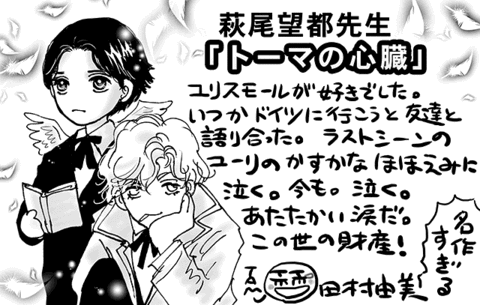
Tamura on Tōma no Shinzō (The Heart of Thomas) by Moto Hagio:
"I loved Julusmole. My friends and I talked about going to Germany someday [because of this manga]. Juli's faint smile in the last scene always makes me cry. Even now. I cry. Warm tears. This manga is a world treasure! (It's too much of a masterpiece)"
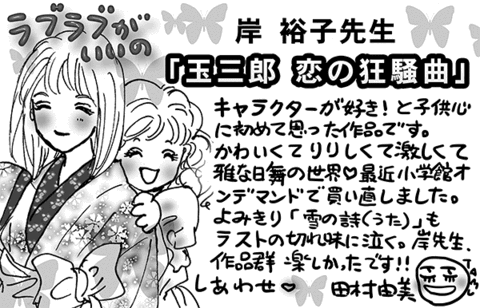
Tamura on Tamasaburō: Koi no Kyōsōkyoku by Yūko Kishi:
"This is the manga in which my young and innocent mind first thought, 'I love the characters!' It shows the cute, dignified, fierce, and elegant world of traditional Japanese dance. I recently bought it again via Shogakukan On-Demand. I cried at the sharp ending in the one-shot, Yuki no Uta. I really enjoyed your works, Kishi-sensei! So happy ♡"
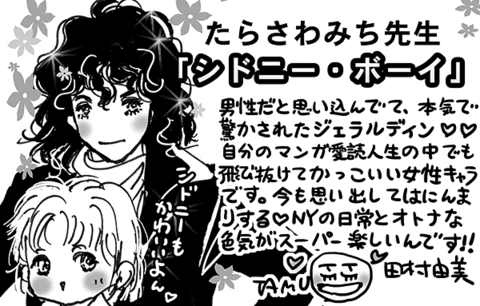
Tamura on Shidonī Bōi (Sydney Boy) by Michi Tarasawa:
"Geraldine seriously surprised me and I was so convinced that she was a man. She's by far one of the coolest female characters I've ever seen in my life as an avid manga reader. Even now, I grin with satisfaction just thinking of her. The everyday life in New York and mature, sexy vibes portrayed in the manga are super thrilling!! (Sydney is so cute too)"
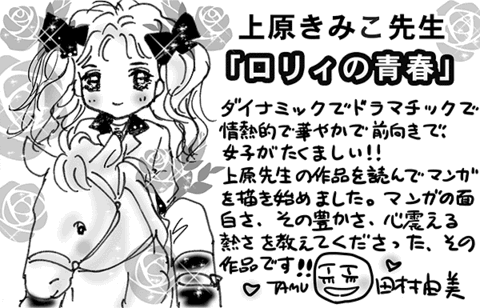
Tamura on Lolly no Seishun by Kimiko Uehara:
"It's dynamic, dramatic, passionate, gorgeous, positive, and is filled with strong, spirited girls!! I started drawing manga after reading Uehara's work. It showed me the fun of manga, its richness and heart-quivering intensity!!"
Disclaimer: These are amateur translations (obviously) and provided for the enjoyment of fans alike (and for personal practice). I do not claim accuracy nor copyright on the translations or content. Feel free to alert me of any corrections.
#tamura yumi#yumi tamura#moto hagio#the heart of thomas#yuuko kishi#tamasaburou#michi tarasawa#sydney boy#kimiko uehara#lolly no seishun#flower comics#tamura tears
37 notes
·
View notes
Text
Illustrations & Comments from Kanoko Sakurakoji & Fumi Yoshinaga in Tribute to Yumi Tamura
Basic translations of the comments by manga-ka Kanoko Sakurakoji (Black Bird; Seirō Opera) and Fumi Yoshinaga (Antique Bakery; Ōoku: The Inner Chambers) in honor of Yumi Tamura, which were published in the Da Vinci magazine August 2020 issue.
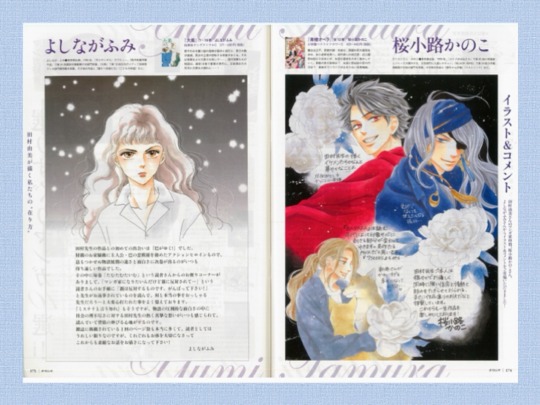
KANOKO SAKURAKOJI

How gorgeous are the handsome men drawn by Tamura...
The overwhelmingly cool Shuri ✧
Ageha, who makes you want to depend on him even though you’re not Sarasa
The impressions and emotionally impactful parts of BASARA will change depending on the era in which you read it. I think that’s why it’s a masterpiece. The same goes for 7SEEDS and other works.
Aramaki is just too cute! Please be happy… ♡
Tamura is gentle and kind, while at the same time, overflowing with strong conviction, passion, and courage. I sense that she’s exactly like her work.
I’m looking forward to enjoying your work for the rest of my life!
-Kanoko Sakurakoji
FUMI YOSHINAGA
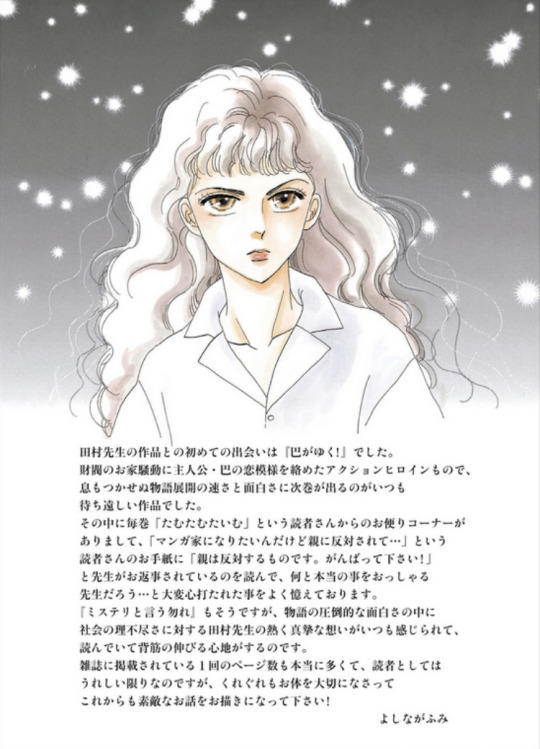
Tomoe ga Yuku! was my first encounter with Tamura’s work.
It’s an action heroine manga in which the love story of the protagonist, Tomoe, is entwined with the family conflict of a business conglomerate. With its exciting and breathtakingly fast-paced development, this work always kept me anxiously waiting for the next volume release.
Within each volume is a special section called “Tamu Tamu Time” for addressing letters from readers, and in response to one reader’s letter that shared, “I want to be a manga artist, but my parents are against it…” Tamura wrote, “Parents always disapprove [of their children’s choices anyway]. So please don’t give up!” I remember reading that and feeling immensely moved by just how honest Tamura was.
It’s the same with Mystery to Iu Nakare, I can always feel Tamura's passionate and sincere feelings towards society’s unfairness within the overwhelmingly gripping story, and reading it makes me feel like standing taller.
As a reader, I’m overjoyed to see you have so many pages published in this magazine, but please take good care of yourself and then continue to draw wonderful stories!
-Fumi Yoshinaga
#Fumi Yoshinaga#Yoshinaga Fumi#Kanoko Sakurakoji#Sakurakoji Kanoko#Yumi Tamura#Tamura Yumi#Tomoe ga Yuku#BASARA#7SEEDS#Tomoe#Tomoe Oujima#Shuri#Sarasa#Ageha#Aramaki#Fubuki#Mitsuru
23 notes
·
View notes
Text
Yumi Tamura Long Interview from Da Vinci August 2020 Issue
Basic translations of the long interview with mangaka Yumi Tamura published in the Da Vinci magazine August 2020 issue. Translation notes appear at the end and correspond with the numbers enclosed in brackets that appear in the body of the post.
<<SPOILER ALERT to anyone who hasn't finished BASARA, and possibly 7SEEDS (though nothing major) if you haven't reached Volume 10/11, specifically the Ash chapter arc on Ryugu Shelter.>>
-----------------------------------
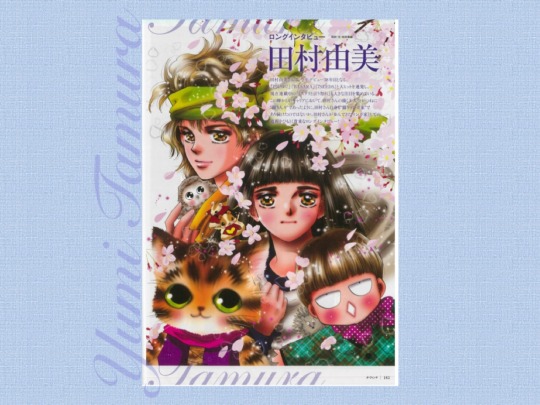
This year marks the 38th anniversary of Yumi Tamura's debut.
Tomoe ga Yuku!, BASARA, and 7SEEDS are big hit series, and her current serialization, Mystery to Iu Nakare, is also attracting a great deal of attention. Throughout her illustrious career, just as her portrayed protagonists have always been "fighting people," she herself has always been a "fighting manga artist.” This is a precious long interview with Tamura that reveals the path she has taken as a manga artist!
The Budding Worldview Begins in a Manga Club
Yumi Tamura opened the door to the world of manga when she was in junior high and high school. It was during this time that she first made many friends who drew manga together.
“I formed a manga club. We weren’t allowed to have a manga club at my school, so I formed an independent one with kids from other schools. After school, we would gather at the house of a member and draw various things. But it's not like we were making proper manuscripts yet at that time. It was more like relay manga [1.], where we would draw with pencils in a notebook. We also made photocopy zines and went to events to sell them. I liked horror and suspense [genres], and now that I think about it, ensemble dramas [2.]. I was creating a single world and putting various characters in it, each with their own story. It was like playing with worlds and characters.”
It was in this manga club that Tamura began walking the path of becoming a professional. In high school, her friends told her they wanted to become manga artists, and in her sophomore year, Tamura, too, finished her first real manuscript and submitted it to Bessatsu Shoujo Comic. It was selected as an honorable mention for the monthly award, and an editor was already assigned to her after her second submission.
“A career as manga artist finally became a reality at this point. When I was deciding on a career path, I thought to myself that I didn’t want to draw manga only as a side job, so I had no choice but to become a manga artist. I entered a design school in Tokyo and worked as an assistant here and there while aiming to make my debut.”
I wanted to draw a hard-boiled suspense with a male protagonist.
For Tamura, the manga club was not only the beginning, but also an important place where the foundation of her career as a manga artist formed.
“The person who influenced me the most in becoming a manga artist was a friend of mine from the manga club. She was a very unique person and a good artist. She would draw pictures of an old Black man playing musical instruments in color. She would also draw stories about the environment from the perspective of a wolf. Seeing her, I realized that I’d be in trouble if I couldn’t draw men and women of all ages too. I started practicing drawing animals, mechanical objects, and with colors. As many of the contributors often say, you should put yourself in an environment where there are people who are clearly better than you. You'll definitely learn a lot that way. If I hadn't met that friend, I don't think I would have become a manga artist.”
Friction Between One's Own Worldview and the Required Worldview
However, after moving to Tokyo, Tamura continued her work in anguish for a brief period. She struggled with the friction between her own view of the world and the so-called shoujo-manga-like worldview.
“I wanted to create a hard-boiled type of story with a male protagonist and with a sense of suspense. But I assumed I couldn't do that for a 32-page piece, so I ended up not knowing what to actually draw for submission. After about two years, I decided that I couldn’t continue this way, so I finally started drawing what I wanted to draw. That was my debut work, Ore-tachi no Zettai Jikan.”
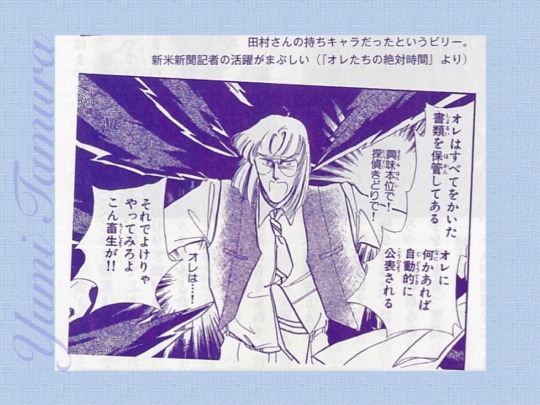
[Image caption: This is Billy, who could be called Tamura’s own fighting game character that she would choose to play. The actions of this rookie newspaper reporter are dazzling! (From Ore-tachi no Zettai Jikan)]
This work won an honorable mention in the Shogakukan Newcomer Comic Award, and was published in an additional issue of Bessatsu Shoujo Comic in 1983. The story begins when Billy, a rookie newspaper reporter, meets a mysterious man who is carrying a dead girl's body.
“Billy is one of the characters in the world that I was creating back in my manga club days. I tried to draw him the way I would like my own selected character [in a fighting video game]. I submitted the work without even showing it to my editor.”
In the 1980s, shoujo manga was in its golden age of school romantic comedies. It could be said that Tamura had begun acquiring her own unique style since the time of her debut.
“It's true that I'm often told that my work is not limited to the boundaries of shoujo manga. But I've never thought of shoujo manga as having any boundaries, and I naturally believe that it has a wide range where anything can be done. I mean I've been reading such stories for a long time. From the perspective of an otaku of my generation, the school romantic comedy genre that everyone often thinks of [and associates with shoujo] is something that came along relatively later.”
However, even after her debut, Tamura still ran into a wall with the worldview requested by the [Bessatsu Shoujo Comic] magazine. Her first serialization was Chotto Eiyuu (Hiirou) shite Mitai. It's a story about a high school girl who plays tennis.
“The person in charge told me that the main character needed to be a girl; that a mystery/suspense was not allowed; that since it’s action, it should be about sports. And that’s how the setting came to be. But because of that, this is a pretty heavy and somewhat bitter memory for me.”
Wanting a Protagonist Who Fights Alongside Men on Equal Footing
The first breakthrough in Tamura’s career came in 1987 with the serialization of Tomoe ga Yuku!. The main character is Tomoe, a delinquent girl who formerly rode roller skates down freeways. She meets Iori, the heir of a business conglomerate, and together they fight to protect him against various threats. With this work, Tamura solidified her position as a popular manga artist. But above all, Tomoe established the heroine image of the "fighting shoujo [girl]" that came to symbolize Tamura's work.
“Tomoe is by no means a strong girl. She is troubled by her own weakness, but she earnestly tries her best to be strong. In Tomoe, for the first time, I put in my own thoughts and problems that I’ve been carrying--the weaknesses, complexes, and worries I had inside me. Though I don't know if that’s an appropriate form for creative work like manga. I'm not a strong person at all, so I tried my best during this time in hopes of becoming strong too. Tomoe runs while crying. I was very happy that readers could relate to that. For the first time in this work, I thought it was fun to have a girl as the protagonist.”
“Thank you for loving me, I will make you happy too.”
We asked once more: In the end, isn't the so-called normal girl, a girl who is loved by a prince-like boy and becomes happy, the kind of protagonist that Tamura should be portraying?
“Of course, I want the protagonist to be loved and happy. But there's a part of me that thinks that she can't really be happy in the way you describe. She’s not an equal [to her partner] somehow, and I feel like sooner or later she’ll be looked down upon or despised as long as that remains the case. It's tiring to be at the mercy of others. For example, even if I do feel loved, I don't want to just be patted on the head; I want to pat your head in return as well. I want to be treated as an equal human being. Thus, I want her to be a girl who says, ‘Thank you for loving me, I will make you happy too.’ For some reason, this kind of awareness has always been with me. When I was a child, I loved tokusatsu [3.] and anime, especially the ones where the lone woman in a group plays the same active role as the men. For example, Françoise Arnoul in Cyborg 009 and Yōko Nogiwa in Key Hunter, though it’s a drama.”
Tomoe was also taken from Tomoe Gozen [4.].
“Tomoe Gozen is said to have charged alongside Kiso Yoshinaka [5.] on the battlefield. I very much admire that kind of relationship. I don't want to simply be told, ‘I'll protect you, so stay back.’ I want to fight together, hand in hand, raising each other up. Well, that's the ideal, but...I know it's difficult to achieve.”
The Idea for Sarasa Came from an Egyptian Queen Who Dressed Like a Man
In 1990, the same year that the serialization of Tomoe ga Yuku! ended, Tamura started serializing BASARA. Including the Gaiden [appendix; side story], the series ran until 1999 and won the 38th Shogakukan Manga Award. This is Tamura's legendary masterpiece that is still loved by many fans. The story takes place in Japan several hundred years after the collapse of civilization. Sarasa, a girl born in the village of Byakko, takes the place of her murdered twin brother, Tatara, and grows up to become the leader of a revolutionary army to save the people suffering under the king's oppressive rule.
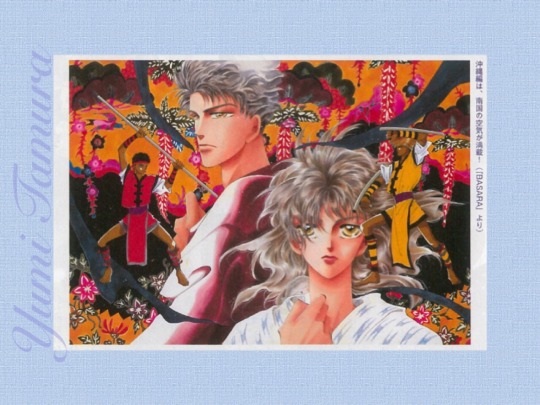
[Image caption: This Okinawa edition is full of tropical flair! (From BASARA)]
“The idea started with a trip to Egypt. There, I learned about the female king, Hatshepsut, who ruled as a pharaoh while dressed as a man, and so I thought it would also be great to have a story about a girl fighting in the disguise of a man. There were already a lot of Egyptian-based stories, so I decided to make a Japanese one, but I thought it would be difficult to portray an actual historical figure since my mind would be wrapped up in historical facts. Thus, it became a fictional war story set in future Japan.”
One of the major attractions of BASARA is the fictional setting of the war. Centered on the imperial capital, Kyoto, Japan is divided into four provinces ruled by the Black King, the Blue King, the White King, and the Red King. There’s a large temple in Kumano and a prison, Abashiri, in the far north. Okinawa is an independent country with a presidential system. It is a world that is slightly connected to the real Japan, yet far more original.
“As usual, I kind of started before really deciding on the detailed setting. I immediately got stuck on what to do next (laughs), but I finally grasped the general idea of how to proceed around the time I put out the Kanmon Tunnel chapters. I realized then that this was indeed going to be a story about Sarasa’s journey around the actual islands of Japan. I guess this was partly due to the influence of role-playing games [6.]. So, as she travels around like that, some real places, such as Sakurajima, appear in the story, while there are other places that have completely changed. I tried to mix in settings that overlap a bit with historical facts and folklore, among trying other things, so it was a lot of fun to create.”
Not Wanting Just Strength; Kindness is Also Necessary
The heart of the story in BASARA is Sarasa’s internal conflict and love. While leading the Tatara army, Sarasa continues to question herself. “Why do I kill people on the battlefield when I want to create a country where people are not killed?” She also then falls deeply in love with the Red King, Shuri, not realizing that he is her own enemy. Sarasa, like Tomoe, is a "fighting girl," but she anguishes and struggles the more deeply she fights and loves.
“Sarasa is also a girl who knows she is weak and keeps struggling to be strong. But in the latter half of the story, she realizes that it’s not enough. Strength alone is not enough; you have to be kind.”
Sarasa reflects: “I thought all I wanted was strength, but every time I come in contact with someone's kindness, I wish I could be kind like them too, I wish I could be even more so; not just strong like Byakko.”
Tamura continues:
“Sarasa is not solely trying to be her brother, Tatara, nor a beautiful woman dressed as a man. She actually loved and lived as a girl. From the beginning of the story to the end, the protagonist has been extremely conscious of the fact that she is a girl. This was a work in which I myself kept thinking about what it meant be a girl.”
After fulfilling her goal of overthrowing the kingdom, Sarasa does not become the head of the new country. She, along with Shuri, disappears from everyone's sight. In the Gaiden, it is mentioned that they crossed over to Europe and established a company called Green Shokai [Green Trading Company].
“I had trouble with the conclusion through the very end. There is still a part of me that doesn't know if them leaving the country was a good choice or not. Maybe Sarasa should have ruled the country. But then, she would have never been able to be with Shuri. I was also very worried about whether or not Sarasa could really forgive Shuri, or if she should. In fact, my editor at one point told me that the two of them should die. But I didn't want to do that. I believed they should live on because they had persevered through so much and fought so hard all that time to be happy. If it had been a short story, I think the ending would have been different. But for this story, it's more meaningful for them to live than to gloriously die a noble death, and even if it's hard, the two of them should bear the burden of their responsibility. The readers called it a job change (laughs), but it’s another way of supporting their country as merchants. In the end, that's how their future together turned out.”
7SEEDS is a School Drama
Tamura's writing prowess continued to grow. In 2001 following BASARA, she launched her other masterpiece, 7SEEDS. The series ran for 16 years and won the Shogakukan Manga Award as well. In the story, five teams of seven people each—Team Spring, Summer A, Summer B, Autumn, and Winter—are put under cryogenic sleep and awaken in the future after the extinction of the human race.
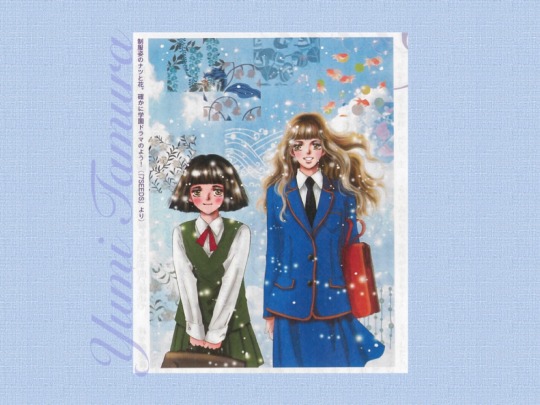
[Image caption: Natsu and Hana in their school uniforms. It certainly looks like a school drama! (From 7SEEDS)]
“Again, I started this one in a hurry before I could really decide on anything (laughs), so I had a rather rough time until about volume 6. I wanted to take a good break for a moment, but it was hard to get one. But then in the chapter arc about Team Summer A at the institute, the story came to me all at once, right up to the final selection test. That was when I remembered the sensation of ��manga is fun!’ for the first time in a long time.”
Even though the setup can be seen as a future survival story, 7SEEDS is a human drama all the way through.
“In my opinion, this work is a school drama. I'm not very good at school stories, so I've rarely written them, but here, there are only boys and girls of about high school-age, and they live together. In the end, it's not a survival know-how story, and of course it's not science fiction; it's a story about how people interact with each other and how they go on living.”
Natsu, who was bullied; Hana and Arashi, who were lovers; Aramaki, a former high school baseball player; and Ango, who carries trauma from his time at the institution. This is the ultimate ensemble drama, with each character having a life of their own to the point where it can be said that all the characters play a leading role.
"Whenever I draw manga, I always think that the supporting characters are not living for the sake of the main character. All of them are living for their own happiness. And it’s when they collide and overlap with each other that the story forms. Also, as is the case with BASARA, even if the young people are the main characters, it’s necessary to depict an adult society in the background—the ideas, expectations, and interests of adults. Only then can that world become one, but that’s the most challenging part.”
There is one chapter arc in 7SEEDS that Tamura herself loves. It's the "Ryugu" shelter, which portrays the time when humanity is on the verge of extinction.
“It seems that many readers are reminded of Ryugu shelter now with the occurrence of Corona [COVID-19 pandemic].”
In the Ryugu shelter, a singer, comedian, ramen chef, dairy farmer, and manga artist all fulfill their professional duties up until the moment of their deaths.
“What would we do if the end of humankind became a reality? I figured that in the end we would do the same thing as they did.”
Dissatisfaction with Gladiator is the Inspiration for Toraji?
One of the most notable aspects of Tamura's career is that while drawing long-running big hits without interruption since the time of Tomoe ga Yuku!, she has been constantly releasing new serialized work and one-shot short stories to the world. When BASARA was in serialization, she created a number of masterpieces, including the Ryuzaburou series featuring a 10-year-old boy, Kinezukan in which a group of senior citizens play an active role, and the horror work 4nin no Onna. And since the start of 7SEEDS, she has started two other series, Neko Mix Genkitan Toraji and Iromen—Juunin Toiro—.
Toraji is a fantasy story set in a world where humans and mice are at war with each other. Hero Pai’yan together along with half-human (mix) cat, Toraji, is searching for his son, who was kidnapped by the Magic Mouse. In Iromen, Aoki, Akagi, Midorikawa, and other men and women with colors in their names fixate on colors and engage in discussions over them at a company.
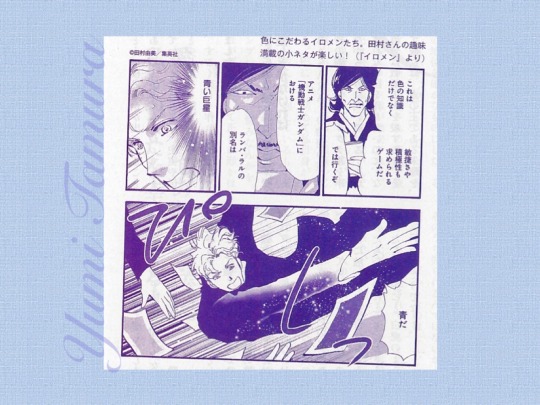
[Image caption: Color-obsessed Iromen [7.]. Tamura’s hobby-filled pieces of tidbits and jokes are entertaining! (From Iromen)]
“The times when I’m in good form are probably when I'm able to work simultaneously on things with slightly different flavors, such as a serious story for the main magazine and a comedy for another. Toraji was inspired by the movie Gladiator. At the beginning of the movie, the main character, a Roman army general, finds his wife and child murdered while he was away in battle. Consequently, the story is about that man fighting as a gladiator for revenge, and of course it’s a magnificent movie, but there was something that made me pause. His wife and child become a very beautiful memory for him; however, he was always away at war and basically neglected them. Isn’t it possible that they hated [him] or was angry with [him]? They weren’t dolls, they were human beings who had feelings and thought about things. But the main character doesn’t think about that even for a minute. I was a little dissatisfied with that, and thus, decided to create Toraji. That’s why Toraji is a story about a son and mother who wants to say to their neglectful father, ‘We are living people too.’”
On the other hand, as for Iromen ...
“It’s like a compilation of myself (laughs). Because I put in real life works like tokusatsu and anime, along with other real products; in other words, I included all the things I like. Moreover, since it was the first time in a long time that I was depicting the present-day real world, it was actually serving as a stepping stone to Mystery to Iu Nakare. After I started the Iromen series, I wrote down notes of proverbs, famous quotes, and anything related to colors. I’ve utilized colors [words, phrases, titles, names, etc.] in BASARA as well. I don’t know much about poetry or literature, but maybe I’m interested in words themselves—in the history of specific words and kanji. I feel like that fixation is gradually showing in my manga.”
Totonou’s Discussions are Something that I’ve Been Thinking About for a Long Time
Mystery to Iu Nakare, which is currently in serialization, also began as a one-shot that was drawn during the same time as 7SEEDS.
“To tell the truth, I had already decided on a different story for the new series. I’ve been wanting to do something a bit like an omnibus for a long time. But fortunately, I received great responses to the Mystery one-shot, so I decided to make it a series.”
Mystery to Iu Nakare has acquired a readership that extends beyond traditional manga fans, and last year it ranked second in the Kono Manga ga Sugoi! 2019 Onna Hen [Kono Manga ga Sugoi! 2019 ranking for female readers] and the Manga Taisho 2019 award list. It is no exaggeration to say that it is one of the hottest manga right now. Perhaps the secret of its popularity stems from the fact that Mystery is packed with everything Tamura has ever done. For example, the main character is a university student named Totonou Kunou. Although he takes on the role of a detective, his true value lies not so much in solving mysteries, but rather, in his sincere point of view on the essence of society and people. He never stays silent when he thinks something is wrong. His inability to read the atmosphere and his reluctance to give up also make him a certain kind of “difficult person.” And Tamura has portrayed many undoubtedly “difficult people” in her works thus far.
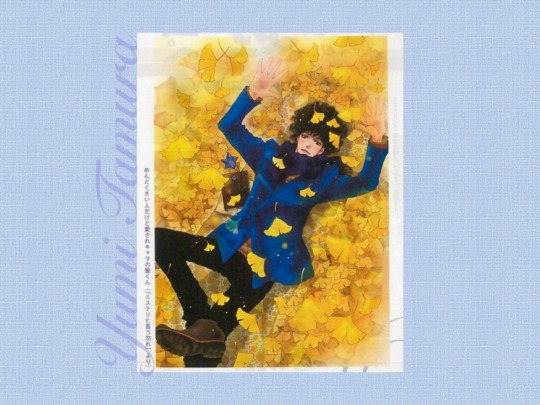
[Image caption: Totonou, who is a difficult type of person, yet a beloved character. (From Mystery to Iu Nakare)]
“I’m the type of person who cannot speak up clearly even when frustrated, so maybe I admire people who don’t keep quiet. People who can think things through and put them into words. Like, ‘I’m not so sure that's the case’ to ‘I think this is wrong.’”
What strongly attracts readers is the numerous words from Totonou, who never remains silent. The gender inequality that still exists in society, the burden placed on mothers in raising children, what it means to love a child, and why it is wrong to kill people… for each of these topics, he gives his own well-thought-out response, addressing them to the people around him as well as to the readers.
“Originally, I didn't start this work with the intention of making it into a mystery, but rather, I was thinking of making it so that Totonou is just there having a conversation while the case is being solved on the side. I wasn’t thinking that he himself would be solving the case. That’s why I titled it with ‘Iu Nakare’ [‘Don’t Say It’ (is a Mystery)], and why the main focus is on his commentary. Everything he says is actually something I've always wondered and kept thinking about. Or, they’re unexpected facts that I learned, or something that surprised me. So, the questions and answers within me at the present moment have become Totonou’s words. Normally, it's not allowed in manga to include the author's thoughts or opinions as they are. However, since Mystery was a one-shot, I thought I’d experiment a bit.”
Among other aspects, Totonou’s strict “No” stance on gender inequality has garnered a great deal of attention.
“Of course, it's not that I want to talk about gender in particular. However, I want to depict what I can now about it too. I think the structure of the world as it exists today is something that was mostly constructed by a small portion of men. Languages, ideas, and systems of the world. Based on said men’s judgment and convenience at that time. That structure is passed down through generations as the natural order of things. I think it’s awfully difficult for women to live as equals with men in a world created in this way. It’s like a pentagon not fitting into a world that’s made for a triangle. In order to make life better for women, I think women need to be involved in the creation of things from the very beginning.”
In that moment, I firmly vowed in my heart: ‘I will become a manga artist!’
Tamura said that an old friend of hers recently pointed out that among all her main characters thus far, Totonou is the closest to Tamura herself. Tomoe, who wished to be strong so that she could fight alongside men; Sarasa, who found kindness before strength; and Totonou, who never averts his eyes from the true nature of society. It can be said that Tamura is a manga artist who is constantly thinking, and her manga is what derives from that. Well, to find out where that driving force to keep on thinking comes from, we finally asked her about it.
"Hmm, a driving force… it starts with the thought of ‘I want to draw this,’ or ‘This would be fun to draw,’ so it normally feels like that, but sometimes there’s an underlying ‘anger.’ There was a moment in high school when I really decided to become a manga artist. At the time, I was very confused about my career path, but there was this one teacher in training who had previously wanted to be a painter but instead chose to become a teacher for the sake of their family. So, I thought I’d try asking them for some advice. When I did, the teacher told me that I should quit if I had any doubts. I nodded my head in agreement, but then they added, ‘But you’re a girl, so you can do whatever you want, right? That’s not the case for men.’ I was both shocked and raging with anger. Angry by that kind of mindset which believes women will get married anyway, so they'll be provided for no matter what becomes of their career [i.e., it doesn’t matter what women do; women have it easy]. Is this something a person who is trying to become a teacher should say? I think on my way home as I rode my bicycle, fire was emitting from my entire body. In that moment, I firmly vowed in my heart: ‘I will become a manga artist!’ In a way, it’s thanks to that teacher…”
However, Tamura says that it doesn’t mean she wants people to agree with her way of thinking.
“I believe that everyone has their own way of thinking. It's also natural for people to think, ‘This seems different or wrong.’ So, it makes sense that the way we look at things changes depending on our situation and circumstances. Everyone has their own truth. That's why human relationships become so complicated.... It would be great if we could talk about that head-on with each other, but I don't think we've learned how to do that very well. It is up to readers to decide how they want to view what I’ve created, so I would be nothing but gratified if they could read my work as they please and enjoy it as reading material. However, there are times when readers tell me that they related to or sympathized with some part of a story, or that it somehow inspired them to think about many things, and that is another outcome that makes me deeply happy and most grateful.”
-----------------------------------
Translation Notes
Relay manga: Manga drawn in relay by several people. For example, one person would draw a panel (without planning what would happen next) and then passes on to the next person to draw a continuation of the story, and this process would continue on until it reaches the last participant.
Ensemble dramas (“gunzougeki”): dramatic production with parallel storylines focusing on different characters; multi-protagonist story, film, etc.
Tokusatsu: genre of live-action film or television drama that makes heavy use of special effects, e.g. Godzilla
Tomoe Gozen: “A female warrior, who appeared in 14th century Japanese literature. According to lore, she served Minamoto no Yoshinaka during the Genpei War and was a part of the conflict that led to the first shogunate. Her family had strong affiliations with Yoshinaka. Although never proven to be a historical figure, her story influenced several generations of samurai. Tomoe is often celebrated in books, music, poems, films, historical novels and popular culture in general.” – Wikipedia
Kiso Yoshinaka: Kiso no Yoshinaka was a general of the late Heian period of Japanese history. – Wikipedia
Yumi Tamura was an avid player of role-playing video games.
‘Iromen’ means color men; a play on ‘ikemen,’ which means good-looking man/men.
DISCLAIMER: This is an unofficial (duh), amateur and very basic translation (with little creative interpretation). Apologies for any typos and sentences that don't make complete sense or are not smoothly constructed. Feel free to message me with any typos, corrections, and/or suggestions. I may get to them before an eternity passes. Thank you! :)
#Tamura Yumi#Yumi Tamura#Ore-tachi no Zettai Jikan#Chotto Eiyuushite Mitai#Tomoe ga Yuku#BASARA#7SEEDS#Neko Mix Genkitan Toraji#Iromen#Mystery to Iu Nakare#Don't Call It Mystery#Ryuzaburou#Da Vinci Magazine#Interview#Tomoe Gozen#Hatshepsut#Tomoe#Sarasa#Natsu#Hana#Arashi#Aramaki#Ango#Toraji#Pai'yan#Aoki#Akagi#Midorikawa#Totonou Kunou#manga
61 notes
·
View notes
Text
Top 10 Manga Picks: the Origins of Manga-Loving Yumi Tamura!
Loosely translated from the Da Vinci Magazine August 2020 issue.
"Tamura has been creating works that span mystery, horror, fictional warfare, action, and fantasy genres. What kind of manga has she been reading up to now? We asked her to introduce the 10 works that inspired her to start drawing manga, as well as what she considers her heart's bible. Includes comments from Tamura herself!"
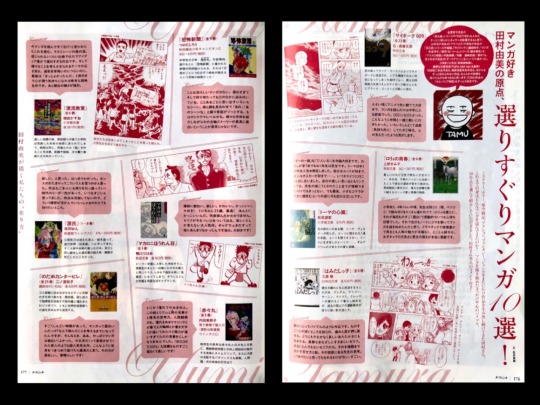
Yumi Tamura's Comments:
1. Cyborg 009 by Shotaro Ishinomori
"When I was little, I watched the anime first and loved it, and then I read the manga around the time I was entering junior high school. I wanted to be 003 and go into battle with friends in the same way. I feel like it was my emotional support during the period of my 2nd year in junior high when I was having a hard time and ran away from it all."
2. Lolly no Seishun by Kimiko Uehara
"When I was in the 3rd or 4th grade of elementary school, Uehara drew a lot of one-shots in Betsucomi ('Lolly' was a weekly comic), and they were so interesting and moving every time that I was constantly in a state of emotion. I think because of that, I began drawing manga in my notebook, splitting up the pages into panels. Dramatic & rich with emotion, the depicted characters by Uehara, whether men or women, are full of charm & utterly brilliant. The energy and willpower of the female characters is really wonderful."
3. Thomas no Shinzou by Moto Hagio
"Of course I love 'Poe no Ichizoku' & '11-nin Iru!' too. Needless to say, Hagio is the greatest treasure. When I was in the 1st year of junior high, my friend & I were crazy about 'Thomas'. I liked Juri and my friend liked Oskar... we talked about going to Germany someday. It links together my own happy memories. I'm sure I didn't understand everything Hagio was trying to draw, but in the end, even now I cry at the image of Juri smiling faintly in a small panel."
4. Hamidashikko by Jun Mihara
"To me, this work is like the bible. It relentlessly strikes the deepest part of the heart and brings forth a flood of pain and tears. It wraps you up in a warmth that's helplessly miserable, sorrowful. Sincere gazes and intense dialogues. The power of the dialogues is truly unbelievable. The way the dialogues are presented along with the drawings make the best use of that power. Mihara's careful thoughts are at the root of all this. Even though I'm already this grateful, I will never get used to it. It's just amazing."
5. Kyoufu Shinbun by Jirou Tsunoda
"This is the most terrifying manga I've ever read. It's so captivating, & even decades later, it's still ingrained in me. There are various scenes that I'll recall whenever something happens. My younger sister & I would look at each other & go like ‘it's that’ or ‘that one scene, right?!’ & it would send shivers down our spines. We're already at a level of trauma. It's uncommon for a main story line to be most interesting while introducing all sorts of horrors."
6. Hyouryuu Kyoushitsu by Kazuo Umezu
"If I was told to read a manga now that would make me cry right away, then I would choose this one. Particularly the last scene of the mother crying. This work is unbelievably fierce, grand, rich in ideas, & just too fascinating. And the themes are so broad & deep that it makes you think about many things. It's a rare transcendental masterpiece that will, in the end, leave you feeling comforted & positive, thinking ‘it was a good ending,’ even though the journey is extremely scary & painful. Also, my contempt for Sekiya is strong.”
7. Macaroni Hourensou by Tsubame Kamogawa
"This is explosively entertaining. Fun. Cute. Cool. I love it! 25-year old Toshi-chan is the best! He's so cool. I don't know how many times I've read this. I still say the lines out loud even now. This is a very popular work that I can only describe as fun. There are not many other gag manga that make me burst out laughing quite like this one. I love it!”
8. Akaaka Maru by Minako Uchida
"I just can't stop admiring this work in general. The drawings, the rhythm, the stunning midpoint [?], the ability to think in a scientific way. And the proficiency of observing people. I admired it so much that I tried drawing contours of people & handwriting with permanent markers & brushes, but my drawing skills were so different that I ended up with nothing but doodles. ‘BOOMTOWN’ & the short stories are also very interesting & fun!”
9. Genji by Yun Kouga
"Innovative, I thought. I could clearly understand it. Kouga seems to be the kind of person who has a lot of sense. I've always thought it was amazing how her work & she herself had leadership qualities of the time to pull others along. I would very much love to know what kind of ideas Kouga has in mind for the rest of this work, since it hasn't been completed yet.”
10. Nodame Cantabile by Tomoko Ninomiya
"There was a period when I was having a very tough time, & it got to the point where I was having unhealthy thoughts like, ‘Is manga even enjoyable?’ But then this work came along & I was like ‘Aah, manga is fun after all! Thank goodness, I'm okay!’ So, this is a super popular & famous work to which I owe a debt of gratitude for making me realize & genuinely feel this way. I think it would be the greatest if I could portray the world in a similar way with such thoroughness. I envy that power of Ninomiya's! It's magnificent!”
Additional side comment from Tamura (in the speech bubble):
“I wanted to include the Bijohime series (Hana no Bijohime) & PARTNER by Tomoko Naka too! (I think it's obvious that these have an influence on my characters.) Other works that also left a strong impact on me are Ryouko Yamagishi's Arabesque; Yuko Kishi's Tamasaburou series and short stories; Rising! (Saeko Himuro/Author, Kazuko Fujita/Artist); the Palm series (Yasei Kemonogi); Astro Kyuudan (Shirou Toozaki/Author, Norihiro Nakajima/Artist); & Dark Green by Junko Sasaki. Makoto Kobayashi's Judo-bu Monogatari & Nanae Haruno's PaPa told me are also excellent! There’re also many other works that I'll never forget, such as those by Shinji Wada & Udou Shinohara, which have all influenced me in some way. I've always loved TONO's Karubania Monogatari too.”

#Yumi Tamura#Tamura Yumi#Cyborg 009#Shotaro Ishinomori#Lolly no Seishun#Kimiko Uehara#Thomas no Shinzou#Moto Hagio#Hamidashikko#Jun Mihara#Kyoufu Shinbun#Jirou Tsunoda#Hyouryuu Kyoushitsu#Kazuo Umezu#Macaroni Hourensou#Tsubame Kamogawa#Akaaka Maru#Minako Uchida#Genji#Yun Kouga#Nodame Cantabile#Tomoko Ninomiya#Tomoko Naka#Ryouko Yamagishi#Yasei Kemonogi#Junko Sasaki#Makoto Kobayashi#Nanae Haruno#TONO#Shinji Wada
60 notes
·
View notes
Text
Mystery to Iu Nakare as Read by Experts: Interview with Sociologist, Noritoshi Furuichi
Translated from the Da Vinci magazine August 2020 issue.
Translation Notes:
1. The popular Japanese saying, "onna no shiawase" (a woman's happiness), carries a connotation implying that what makes a woman happiest is being primarily a loving homemaker. It suggests that her happiness lies in her success as a wife, helpmate, and mother.
~~~~~~~~~~~~~~~~~
What was your impression after reading Yumi Tamura's latest work, Mystery to Iu Nakare?
"What Totonou is unraveling is not a mystery case but a person's heart. He's more of a therapist than a detective," says Mr. Noritoshi Furuichi, who was impressed by the first story.

Totonou, who becomes a murder suspect, says the following during interrogation to the police sergeant who believes that "there is only one truth": "Getting caught up in something so ambiguous, like 'the truth,’ is what causes false accusations.”
Furuichi: "The stance taken by Totonou, who says that there are as many truths as there are people, and who tries to see the world in a flat way, is the core of this work as well as the antithesis of detective fiction. This is something I've always wondered, but most detective stories seem to end when the culprit is caught. But, merely revealing the facts doesn't solve anything. From the day the case closes and onward, the grief of the victims and the troubles of the perpetrators will continue. And that period of time is far much longer. The perspective that there’s no such thing as a single happy ending in reality is what makes this work so interesting."
Everyone who comes into contact with Totonou has their own beliefs and contradictions shattered. In the process, readers are also made aware of the things that have unconsciously bound them.
Furuichi: "I've been reading Tamura's works for a long time, including BASARA, but this one seems particularly tough on the "uncles." The old men who tend to believe that men go to work and women stay at home; who uphold a seniority-based hierarchy where they obey their superiors and give orders to their subordinates; and who put on airs just because of their titles. Through Totonou, this work casts a strong suspicious eye on those men. This specific line in volume 3 gave me quite a shock: "Don't fall for notions like 'a woman's happiness' [1.] either. Because they were probably made up by old men." This line points out that words accepted as truth in our society may actually be just prejudices that are convenient for someone else. However, the work achieves this kind of critique without being preachy. I think this is because the protagonist is always sincere with and serious about the people he faces. That's why all the people who meet him feel enabled to think for themselves and choose to change after being persuaded by his honesty. Totonou is actually very kind. He's usually not too involved with people, but when he realizes the crime by Garo, whom he grew fond of, he properly points it out. He doesn't turn a blind eye in order to be liked. Instead, once he's involved, Totonou continues to worry about Garo and tries to take responsibility for his actions. I believe being reasonable to yourself and to others will ultimately lead to kindness."
By the way, Mr. Furuichi, you naturally used some of Totonou's sayings as your own, but what part of him do you feel is similar to yourself?
Furuichi: "I've had friends say that to me, but I'm not so sure... (laughs). But I guess we're similar in that I do question a lot of things and end up offending someone. I just think it's important to ask, 'really?,' like Totonou, and question the existing state of things. In this society, there is a lot of common sense that makes no sense and customs that are no longer useful. They will continue to exist until someone calls them out. In order to improve and make society more open-minded, we need someone to intervene and question. I wish more people had a Totonou within them. Though more arguments and conflicts would probably arise here and there."
#Mystery to Iunakare#Don’t Call It Mystery#Do Not Say Mystery#Yumi Tamura#Tamura Yumi#Da Vinci Magazine August 2020 Issue#Noritoshi Furuichi#unofficial translations
88 notes
·
View notes